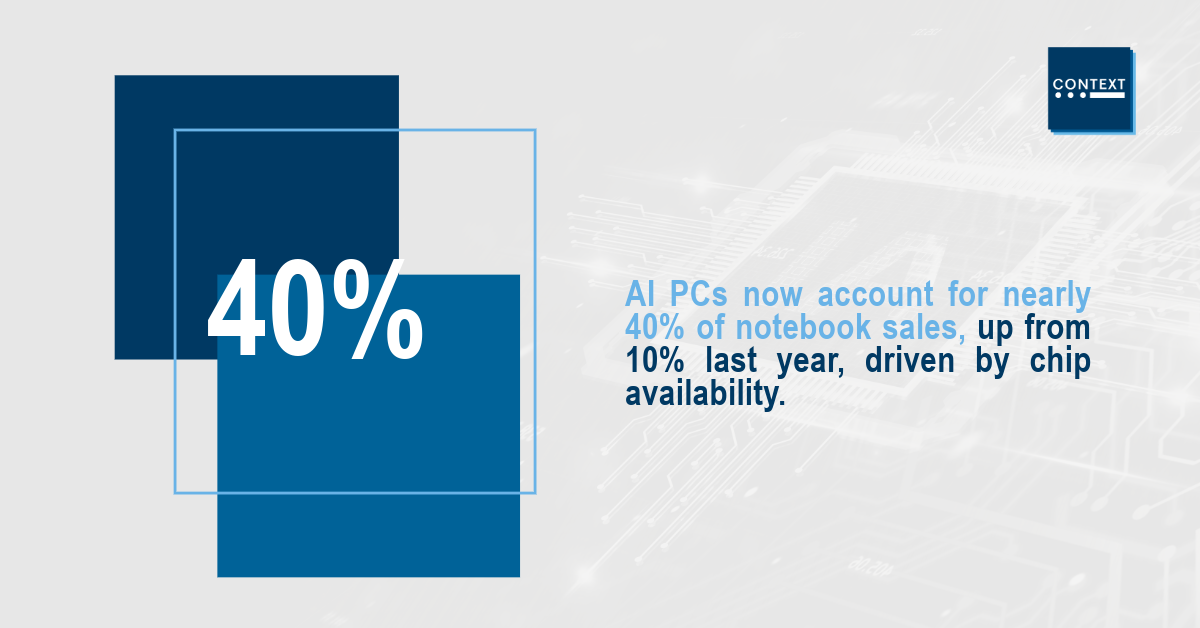KEY TAKEAWAYS
- Manufacturer-Driven Growth –
AI PC sales are rising due to industry push, not strong consumer
demand.
- High-End AI PCs
Struggle – Premium models face slow adoption due to high prices,
unclear benefits, and compatibility issues.
- User Value is Key – AI PCs will succeed
when they prove real productivity benefits, driving genuine
demand.
The AI PC market evolution is well
underway, but is it genuinely being driven by demand? We take a look
at how the dynamic is being accelerated by the industry itself as chip
manufacturers go to market with AI–capable processors, ensuring
adoption grows regardless of immediate consumer appetite.
At the beginning of 2025, AI
PCs—defined as devices with system-on-chips (SOCs) integrating AI
accelerators such as neural processing units (NPUs)—accounted for
nearly 40% of notebooks sold through the largest European
distributors. This is according to our latest market intelligence.

A year ago, this figure stood at
just 10%. The rapid growth is clear, but the driving force behind it
is not overwhelming consumer demand. Rather, it is the availability
of AI-capable chipsets, as more manufacturers integrate these into
new notebook models. The rise in adoption is a by-product of product
rollouts rather than a surge in users actively seeking AI-powered features.
High-performance AI PCs,
particularly those classified under Microsoft’s Copilot+ category
with NPUs of 40 TOPS or more, tell a different story. Since their
launch in mid-2024, their adoption has remained sluggish, hovering
at just 5% of AI PC sales. Unlike mainstream AI PCs, which benefit
from a steady push in availability, Copilot+ products have struggled
to find a foothold in the market.
There are several factors holding
back their wider adoption. The first is price. Copilot+ devices
carry a significant premium, but the added value they offer is still
not clearly defined. While AI capabilities sound impressive,
consumers and businesses alike remain unsure of how these features
will genuinely enhance their computing experience. This lack of
clarity, combined with tight budgets, means there is little urgency
to invest in these premium devices. Beyond cost concerns, there are
lingering questions over compatibility. The first wave of Copilot+
PCs is powered by Qualcomm’s Snapdragon X processor, which is
ARM-based, whereas the majority of commercial users rely on Intel
and AMD’s x86-based architecture. This presents potential software
compatibility issues, particularly for enterprises reliant on legacy applications.
Despite these challenges, Copilot+
adoption is expected to rise, albeit gradually. Recent chip launches
signal a shift in the market. Qualcomm’s latest Snapdragon X
releases are targeting lower price points, which should help make
high-performance AI PCs more accessible. Software compatibility issues
will be resolved over time. Intel and AMD have also entered the
Copilot+ space with new AI-capable chips, including designs
specifically aimed at commercial users.
The true test for AI PCs will be
how their capabilities evolve to meet user needs. As the industry
refines AI applications, a clearer picture of how these machines
will enhance productivity and collaboration should emerge. This year
is likely to bring progress in understanding AI PC functionality,
with 2026 expected to see a shift from passive adoption to genuine
consumer demand. The AI PC revolution is inevitable, but it is still
waiting for its defining moment.
Stay up to date
on the latest market intelligence for the IT channel,
by tuning into CONTEXT’s weekly IT Industry Forum
webinars.